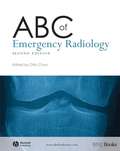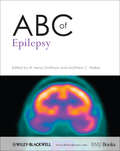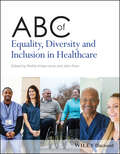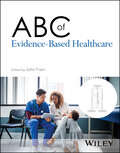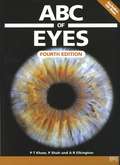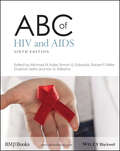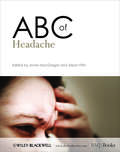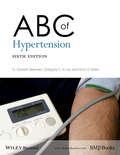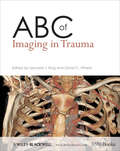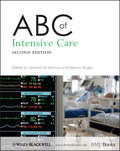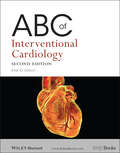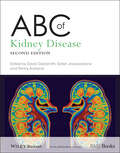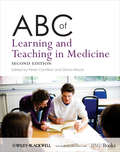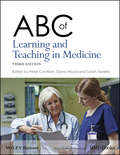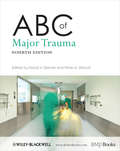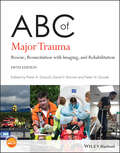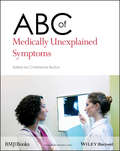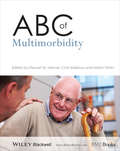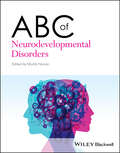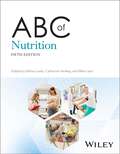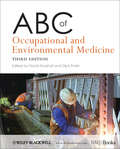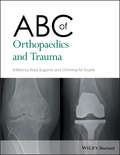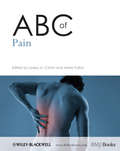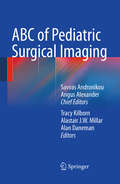- Table View
- List View
ABC of Emergency Radiology
by Otto ChanA great source of examples that can be referred to in the heat of emergency.Mistakes can easily be made when interpreting emergency radiographs. The situation is often made more difficult by the urgency and circumstances in which the radiograph has to be evaluated.This book describes a systematic approach to assessing radiographs, instructing you on the appearances of radiological abnormalities and comparing these with normal radiographs.Each chapter covers a different part of the body and leads you through the anatomy, followed by the different types of view to request, the system of assessment itself, and pitfalls to avoid.With its clear explanation, combined with over 400 radiographs and illustrations, this essential book provides a great source of examples that can be referred to in the heat of an emergency.It will be invaluable for accident and emergency staff, trainee radiologists, medical students, nurses, and radiographers.
ABC of Epilepsy
by Matthew C. Walker W. Henry SmithsonABC of Epilepsy provides a practical guide for general practitioners, and all those working in primary care, on the diagnosis, treatment and management of epilepsy, and for the continued monitoring and long term support of what is still a relatively poorly understood neurological disorder.This brand new title in the ABC series is highly illustrated throughout and presents what epilepsy is, its classification, and how to diagnose it. It covers anti-epileptic drugs and non-drug treatments, as well as self-management and living with epilepsy.Edited by a general practitioner and neurologist team, the ABC of Epilepsy reflects current NICE guidelines and is ideal for all GPs, primary health care professionals, practice nurses and specialist nurses, and non-specialist medical staff who play an increasing role in monitoring and managing of epilepsy patients.
ABC of Equality, Diversity and Inclusion in Healthcare (ABC Series)
by John Frain Shehla Imtiaz-UmerABC of Equality, Diversity and Inclusion in Healthcare ABC of Equality, Diversity and Inclusion in Healthcare Improve inclusion, for both patients and staff, in your healthcare environment Fulfilment in personal and professional life is facilitated by feeling able to bring one’s complete self to work. The promotion of Equality, Diversity & Inclusion (EDI) and its support in the workplace is crucial to achieving this. Diverse and inclusive teams are characterised by good people management, leading to better decision-making and improved performance which staff wellbeing and patient safety depend on. Though issues including racism, sexism and homophobia have roots in wider society, they also exist across healthcare systems worldwide. They contribute to problems with recruitment and retention of staff and can make patients reluctant to access the care they need and deserve. The ABC of Equality, Diversity and Inclusion in Health summarises the key issues and the impacts on both patients and staff of excluding people from good healthcare solely on the basis of who they are. As well as considering impacts on individuals and teams, we consider also how inclusion can be improved for the benefit of everyone—all patients and all staff. Topics include: Racism in healthcare Women in healthcare Sexual orientation and gender identity Disability, disparities and ableism in medicine Teaching equality, diversity, and inclusion in healthcare The authors are distinguished healthcare practitioners whose personal and professional lives have been enriched by the diversity of all they meet through their work and who are passionate about ensuring positive change for colleagues and patients. This book aims to contribute to important discussions about how to ensure systemic change that will enable an inclusive culture by recognising and celebrating diversity. ABC of Equality, Diversity and Include (EDI) in Healthcare is essential reading for students and professionals who want to champion inclusivity and fulfilment in a workplace environment. About the ABC series The ABC series has been designed to help you access information quickly and deliver the best patient care, and remains an essential reference tool for GPs, junior doctors, medical students and healthcare professionals. Now offering over 80 titles, this extensive series provides you with a quick and dependable reference on a range of topics in all the major specialties. The ABC series is the essential and dependable source of up-to-date information for all practitioners and students in primary healthcare. To receive automatic updates on books and journals in your specialty, join our email list. Sign up today at www.wiley.com/email
ABC of Evidence-Based Healthcare (ABC Series)
by John FrainABC of Evidence - Based Healthcare A practitioner guide summarizing the aims and achievements of evidence-based healthcare and why it is crucial to modern clinical practice ABC of Evidence-Based Healthcare explains how evidence is developed and formulated into guidance for clinicians. It details how to interpret and apply this evidence to one’s own practice and patients, covering areas such as diagnosis and screening, therapy, harm, and prognosis. Some of the key aspects discussed in this book include understanding choice of study design, the roles of quantitative and qualitative research, selecting and using appraisal tools and key statistical concepts. Additionally, the book also covers how to interpret the results of research studies, apply results to the needs of patients, communicate results to colleagues and incorporate them into student training, as well as discussing treatment options, risks, and benefits with patients. As in all ABC books, the text is complemented with practical examples of evidence in practice to facilitate understanding. Although a standalone resource in itself, the book signposts readers to useful and comprehensive resources, including web-based calculators and tools for each main theme of the book. In ABC of Evidence-Based Healthcare, readers will find information on: The ethical dimension, philosophy, scope, achievements, and usefulness of evidence-based healthcare Pre-appraised versus primary studies, healthcare databases, and search strategies including the use of keywords, wildcards, and filters Statistical concepts including probability and confidence intervals, and cohort, diagnostic accuracy, and case control studies Bias in research, the impact of under-research, conflicts of interest, and misleading or weak evidence Curriculum development, covering objectives and outcomes, curriculum integration, and student assessments ABC of Evidence-Based Healthcare delivers a practical, accessible, and highly useful introduction to concepts of evidence-based healthcare for students and new practitioners.
ABC of Eyes (ABC Series #11)
by Andrew R. Elkington Peter Shah Peng T. KhawIn the three years since the 3rd edition much has changed in the treatment of eye conditions. Glaucoma and macular degeneration, laser treatment compared with surgery, how to deal with refractive errors - all these will be described in detail and illustrated with newly commissioned drawings and photographs.
ABC of HIV and AIDS
by Ian Williams Robert F. Miller Michael W. Adler Gulshan Sethi Simon G. EdwardsAn authoritative guide to the epidemiology, incidence, testing and diagnosis and management of HIV and AIDS.From an international expert editor and contributor team, this new sixth edition includes expanded coverage of HIV testing, assessment and routine follow up and new chapters outlining problematic conditions associated with HIV and AIDS. Prevention strategies, early diagnosis and antiretroviral drugs and pharmacotherapy are covered in detail as well as children and women with HIV. It also addresses key psychological and mental health issues, patient perspectives and the role of patient engagement. As knowledge into the illness grows and major advances in HIV therapy see more people living with HIV in the community, the ABC of HIV and AIDS, 6e provides clear practical guidance for general practitioners, hospital doctors, nurses, medical students, counsellors, allied health workers and anyone working and caring for patients with HIV and AIDS.
ABC of Headache
by Anne Macgregor Alison FrithIn its different presentations, headache is one of the most common symptoms seen by family practitioners. The difficulty is in diagnosing the cause of the headache so that the appropriate treatment is provided, or if referral to a specialist is the recommended course of action. The ABC of Headache helps with this dilemma and guides the healthcare professional to look for the possible causes of presenting symptoms. Based on real case histories, each chapter guides the reader from symptoms through to diagnosis and management. This new ABC is a highly illustrated, informative, and practical source of knowledge. With links to further information and resources, it is a valuable text for healthcare professionals at all levels of practice and training.
ABC of Hypertension
by Gareth Beevers Gregory Y. Lip Eoin O'BrienHigh blood pressure is a common chronic medical problem encountered in primary care, yet it is commonly under diagnosed. ABC of Hypertension is a long established, practical guide to the investigation, treatment and management of hypertensive patients. This sixth edition:Provides practical guidance on measurement of blood pressure and the investigation and management of hypertensive patientsExplains new developments in measurement and automated measurement of blood pressure andUpdates coverage on treatment of the elderly and explains of the implications of recent trialsIncorporates current British Hypertension Society and NICE guidelines
ABC of Imaging in Trauma
by David C. Wherry Leonard J. KingAn understanding of current trauma imaging concepts is essential for all medical personnel involved in the care of trauma patients where the outcome may depend on a rapid assessment of the nature and severity of injuries, allowing appropriate medical management and surgical or non-surgical intervention.Containing more than 300 state of the art full colour images, the ABC of Imaging in Trauma addresses this increasingly important area and provides a concise and practical guide to the role, performance and interpretation of emergency imaging procedures in disaster victims and major trauma patients, and focuses on the use of CT, ultrasound, and MRI scanning to diagnose such patients. It is ideal for the non specialist and emergency physicians, Foundation doctors, trainee radiologists, and specialist trauma nurses.
ABC of Intensive Care
by Graham R. Nimmo Mervyn SingerThis new and updated edition is a practical guide to intensive care for the non-specialist, providing the core knowledge and principles of intensive care patient management.From general principles through to critical care outreach and end of life care, it covers best practice management in the intensive care unit. It includes the key organ system support as well as monitoring, sepsis, brain-stem death, and nutrition in intensive care. There is also full coverage of organ donation.This invaluable resource is highly illustrated in colour throughout with new images, references to key evidence, and further reading and resources in each chapter. It is ideal for junior doctors, medical students and specialist nurses working in an acute hospital setting and the ICU and neonatal ICU, and for anyone involved in the management and care of intensive care patients.Endorsed by the Intensive Care Society (UK) and the Scottish Intensive Care Society.
ABC of Interventional Cardiology
by Ever D. GrechThis fully updated, new edition of ABC of Interventional Cardiology is an easy-to-read, practical guide for the non-specialist. It presents the complex aspects of interventional cardiology in a clear and concise manner, and explains the different interventions for coronary artery disease, valvular and structural heart disease, and electrophysiology, ordered by clinical setting. The ABC of Interventional Cardiology covers the core knowledge on techniques and management, and highlights the evidence base. Illustrated in full colour throughout, with new images and graphics, it includes key evidence and guidelines, new drug treatments and devices, with recommendations for further reading and additional resources in each chapter. It is ideal for GPs, hospital doctors, medical students, catheter laboratory staff and cardiology nurses.
ABC of Kidney Disease
by Satish Jayawardene Penny Ackland David GoldsmithThe ABC of Kidney Disease, Second Edition is a practical guide to the most common renal diseases to help healthcare professionals screen, identify, treat and refer renal patients appropriately and to provide the best possible care.Covering the common renal presentations in primary care this highly illustrated guide provides guidance on symptoms, signs and treatments, which tests to use, measures to prevent progression, and when and how to refer. Fully revised in accordance with current guidelines, it also includes organizational aspects of renal disease management, dialysis and transplantation. The appendices contain an explanatory glossary of renal terms, guidance on anaemia management and information on drug prescribing and interactions.The ABC of Kidney Disease, Second Edition is an ideal practical reference for GPs, GP registrars, junior doctors, medical students and for anyone working with patients with renal related conditions.
ABC of Learning and Teaching in Medicine
by Diana Wood Peter CantillonThe ABC of Learning and Teaching in Medicine is a fully revised, succinct resource for both novice and experienced medical teachers. It is an excellent introductory text for doctors and other health professionals starting out in their careers as well as offering teaching tips and new perspectives for busy practitioners wishing to keep abreast of developments in medical education.The ABC emphasises the teacher's role as a facilitator of learning rather than a transmitter of knowledge. It is designed to be practical and accessible and will support good teachers in becoming even better at what they do. Each chapter seeks to explain how different aspects of learning and assessment work (the theory) as well as providing descriptions of educational approaches that work (the practice).This fully updated new edition features core medical education topics such as course design, assessment, learning in groups, feedback, and the creation of learning materials. It also includes invaluable new chapters that address many of the challenges of medical education such as dealing with students in difficulty, the teaching of professionalism in clinical settings, and how to support the development of teachers. Together, these chapters represent an authoritative guide written by a team of educational experts of international renown and is suitable for all health professional educators.
ABC of Learning and Teaching in Medicine
by Diana Wood Peter Cantillon Sarah YardleyABC of Learning and Teaching in Medicine is an invaluable resource for both novice and experienced medical teachers. It emphasises the teacher’s role as a facilitator of learning rather than a transmitter of knowledge, and is designed to be practical and accessible not only to those new to the profession, but also to those who wish to keep abreast of developments in medical education. Fully updated and revised, this new edition continues to provide an accessible account of the most important domains of medical education including educational design, assessment, feedback and evaluation. The succinct chapters contained in this ABC are designed to help new teachers learn to teach and for experienced teachers to become even better than they are. Four new chapters have been added covering topics such as social media; quality assurance of assessments; mindfulness and learner supervision. Written by an expert editorial team with an international selection of authoritative contributors, this edition of ABC of Learning and Teaching in Medicine is an excellent introductory text for doctors and other health professionals starting out in their careers, as well as being an important reference for experienced educators.
ABC of Learning and Teaching in Medicine (ABC Series #176)
by Peter Cantillon and Diana WoodThe ABC of Learning and Teaching in Medicine is a fully revised, succinct resource for both novice and experienced medical teachers. It is an excellent introductory text for doctors and other health professionals starting out in their careers as well as offering teaching tips and new perspectives for busy practitioners wishing to keep abreast of developments in medical education. The ABC emphasises the teacher’s role as a facilitator of learning rather than a transmitter of knowledge. It is designed to be practical and accessible and will support good teachers in becoming even better at what they do. Each chapter seeks to explain how different aspects of learning and assessment work (the theory) as well as providing descriptions of educational approaches that work (the practice). This fully updated new edition features core medical education topics such as course design, assessment, learning in groups, feedback, and the creation of learning materials. It also includes invaluable new chapters that address many of the challenges of medical education such as dealing with students in difficulty, the teaching of professionalism in clinical settings, and how to support the development of teachers. Together, these chapters represent an authoritative guide written by a team of educational experts of international renown and is suitable for all health professional educators.
ABC of Major Trauma
by David V. Skinner Peter A. DriscollPrehospital care is a growing area in medicine, and emergency treatments are becoming more sophisticated as the potential to save lives grow. The fourth edition of this ABC has been thoroughly updated and includes new chapters on nuclear and biological emergencies. Each chapter gives concise and clear guidance and is accompanied by excellent photographs and diagrams. Edited and written by leading UK trauma authorities, this is a truly comprehensive and practical book for everyday use by emergency medicine staff, nurses, hospital doctors, paramedics, and ambulance services.
ABC of Major Trauma: Rescue, Resuscitation with Imaging, and Rehabilitation (ABC Series #246)
by David V. Skinner Peter A. Driscoll Peter N. GoodeABC of Major Trauma ABC of Major Trauma, Fifth Edition An authoritative overview of the management and treatment of major trauma patients In the newly revised, and substantially expanded, Fifth Edition of ABC of Major Trauma, an eminent team of leading trauma specialists delivers a comprehensive, up-to-date, referenced overview of the emergency treatment of patients suffering from major trauma. Covering all aspects of the management of injured patients during the initial, crucial hours after injury, the scope of the book has developed to include imaging appendices for many chapters. The editors have included resources that discuss general considerations for typical trauma cases, as well as the numerous atypical patients including children, the elderly and those who are pregnant. Hyperlinks are now also included throughout the book which enable the reader to refer to continuously updated guidelines. The book also offers: A thorough introduction to the development and organisation of trauma services, including pre-hospital care and major incidents. A guide to the modern trauma team personnel from airway doctor, to trauma nurse, to trauma team leader, while describing the technical and non-technical skills required for the ABCDE of trauma resuscitation, imaging and the subsequent transfer of the patient. Specialist chapters on ballistic trauma, chemical contamination and burns as well as the management of trauma in specialist patient groups including paediatrics, pregnancy, and the elderly. A new and vital chapter on rehabilitation as well an expansion of the measurement of trauma outcomes to include disability and a discussion on how such audits can drive further improvement. Perfect for all those involved in the care of the trauma patient, including nurses, physician associates, hospital doctors, paramedics and pre-hospital teams, the ABC of Major Trauma is a one-stop referenced guide to the care of such patients from the site of injury to maximal recovery. About the ABC series The ABC series has been designed to help you access information quickly and deliver the best patient care, and remains an essential reference tool for GPs, junior doctors, medical students and healthcare professionals. Now offering over 80 titles, this extensive series provides you with a quick and dependable reference on a range of topics in all the major specialties. The ABC series is the essential and dependable source of up-to-date information for all practitioners and students in primary healthcare. To receive automatic updates on books and journals in your specialty, join our email list. Sign up today at www.wiley.com/email
ABC of Medically Unexplained Symptoms
by Christopher BurtonThis brand new title addresses the complex issues faced by primary health care practitioners in treating and managing patients with 'medically unexplained symptoms'. It aims to develop guidelines and principles to help identify patients with medically unexplained symptoms, as they are typically underdiagnosed, and to manage symptoms more effectively with active patient involvement.
ABC of Multimorbidity
by Martin Fortin Stewart Mercer Chris SalisburyABC of Multimorbidity is the first title to provide primary care practitioners with a practical approach to the complex issues of treating and managing patients with more than one morbidity.Ageing populations and earlier diagnosis of chronic conditions mean more people are living longer with multimorbidity. However, treatment guidelines are often designed for treatment in isolation of other morbidities. Multimorbidity management therefore requires a more patient centred approach and greater knowledge and coordination of existing services. Effective multimorbidity management both improves overall patient well-being and reduces the overall demand on health services.ABC of Multimorbidity examines how multimorbidities can be addressed within primary care, from the GP and family physician consultation through to the effective use of a range of health care services. It addresses complex issues such as polypharmacy, mental health, patient safety, patient involvement in self-management, and the role of the practitioner. It then provides guidance on how multimorbidities can be best treated and managed within primary care through specific interventions to improve outcomes.From an international, primary care editor and contributor team, ABC of Multimorbidity is a practical resource for general practitioners, family physicians, practice and specialist nurses, and others caring for multimorbid patients. It is also relevant for junior doctors, medical trainees and students.
ABC of Neurodevelopmental Disorders (ABC Series)
by Munib HaroonABC of Neurodevelopmental Disorders An accessible and up-to-date discussion of the most common neurodevelopmental disorders ABC of Neurodevelopmental Disorders In ABC of Neurodevelopmental Disorders, Dr Munib Haroon delivers an insightful and practical introduction to various neurodevelopmental conditions, as well as discussions about their most common comorbid mental health conditions. The author offers a broad overview of neurodiversity and neurodevelopmental disorders to help you understand how people who are neurodivergent may present in a clinical environment, how they should be assessed, and how they can best be managed. Each chapter provides a list of resources for further reading and for exploring these evolving, important, and fascinating topics in greater detail. You’ll also find: A thorough introduction to ADHD, autism, intellectual developmental disorders, tics and Tourette’s disorder, developmental co-ordination disorder and specific learning disorder An introduction to clinical and non-clinical outcomes for different neurodevelopmental disorders Chapters on the assessment of mental health conditions in children, young people and adults with neurodevelopmental disorders Discussion about the genetic basis of neurodevelopmental disorders, including a specific chapter on this topic A standalone chapter on Foetal Alcohol Spectrum Disorder Aimed at doctors and mental health practitioners including community paediatricians, psychiatrists, psychologists, counsellors, addiction specialists, social workers and trainees in these fields. ABC of Neurodevelopmental Disorders will also benefit healthcare workers who regularly treat neurodivergent people in a variety of settings.
ABC of Nutrition (ABC Series)
by Catherine Hankey Mike Lean Wilma LeslieABC of Nutrition A practical guide to nutrition and the health problems related to foods and diet, covering body composition, epidemiology, specific populations, and more ABC of Nutrition is a comprehensive guide to nutrition as it relates to the causes, treatment and management of the symptoms and medical conditions frequently met by healthcare professionals. Beginning with a new introduction to principles of nutrition and definitions of terms, this revised and updated fifth edition includes new chapters on nutrition for special populations, such as pregnant women, children, and the elderly, and on the use of products marketed for sports and performance enhancement. This new edition also features the latest National Institute for Health and Care Excellence guidelines on Nutrition Support for Adults, as well as guidance on Maternal and Child Nutrition. Written by a team of experts with a range of professional perspectives, ABC of Nutrition includes valuable, practical information based on clinical evidence, in an easily accessible way. Areas covered include: Vitamins and minerals, salt and sodium, fats, carbohydrates, and proteins Nutritional deficiencies in both developing and affluent countries, and the role of functional foods and nutrient fortification in addressing these deficiencies Nutrition’s role in heart disease, blood pressure, chronic diseases such as diabetes, and some types of cancer Challenges of weight management, eating disorders, and obesity for individuals and in the sphere of public health Addressing the large amount of misinformation circulating in the media about foods and health ABC of Nutrition is an essential, stimulating read, aimed at providing confidence when advising about diet and nutrition for healthcare professionals, practitioners, and students in many fields.
ABC of Occupational and Environmental Medicine
by David Snashall Dipti PatelThis new edition of Occupational and Environmental Medicine concentrates more on the newer kinds of occupational disease including those (like "RSI" and pesticide poisoning) where exposure and effects are difficult to understand. There is specific emphasis on work, health and wellbeing, with links to public health, health promotion, the value of work, disabled people at work, the aging workforce, vocational rehabilitation, evidence based practice, and further chapters on the health effects of climate change and of occupational health and safety in relation to migration and terrorism.
ABC of Orthopaedics and Trauma (ABC Series #257)
by Kapil Sugand Chinmay M. GupteFully illustrated throughout with a wide range of scans, images and line drawings, ABC of Orthopaedics and Trauma provides practical guidance on the diagnosis, treatment and management of orthopaedic conditions, and assists with the initial assessment based on common presentations. Written by a team of renowned expert orthopaedic surgeons and rheumatologists, it includes coverage of the current national guidelines from NICE and professional bodies. Twenty-four chapters cover all the major areas of this vast speciality using a digestible and reader-friendly approach, including sections on fractures, joint replacements, rheumatological disorders, osteoarthritis, emergencies, and post-operative care. Introduction to specialist topics like metabolic bone disease, peripheral nerve injury, paediatric orthopaedics and tumours are also featured. Topics consist of history and examination, investigation and initial management of common orthopaedic trauma and elective presentations. In addition, this full-colour, user-friendly reference guide offers readers a look at the day-to-day clinical practice of a speciality that will affect at least half of the global population at some point, covering further chapters on epidemiology, biomechanics, common procedures, future developments and education. ABC of Orthopaedics and Trauma is an excellent resource for all healthcare professionals caring for patients with musculoskeletal and orthopaedic related disorders. This will be a valuable reference to orthopaedic trainees, sports physicians, physiotherapists, nurses, occupational therapists, clinical researchers and student doctors.
ABC of Pain
by Lesley A. Colvin Marie FallonChronic pain is a very common problem, impacting on many patients. Assessment and management can be challenging. The ABC of Pain focuses on the pain management issues often encountered in primary care.Covering major chronic pain presentations, such as musculoskeletal pain, low back pain and neuropathic pain, the ABC of Pain also provides guidance on the management of pain in pregnancy, children, older adults, drug dependency and the terminally ill. Beginning with an overview of the epidemiology of chronic pain, pain mechanisms and the assessment of pain, it then provides practical guidance on interventional procedures and methods of effective pain management.The ABC of Pain is a comprehensive, evidence-based reference. It is ideal for GPs, junior doctors, nurse specialists in primary care, palliative care specialists, and also hospital and hospice staff managing chronically and terminally ill patients.
ABC of Pediatric Surgical Imaging
by Angus Alexander Tracy Kilborn Alastair J. Millar Savvas Andronikou Alan DanemanThis book has been designed to serve as a quick reference that will assist in decision making. The book is ordered alphabetically according to diagnoses. The intention is that the clinician consults the information on a suspected diagnosis, and then considers the listed surgical and radiological differential diagnoses. A total of 80 common diagnoses are covered. For each diagnosis, the left-hand page presents information relevant to the surgeon, while the right-hand page is designed for the radiologist. The information for the surgeon comprises clinical insights, including symptoms, warnings, controversies, other important facts, and the surgical differential diagnosis. The radiologist is provided with lists of the primary and follow-on investigations, the imaging findings, and helpful tips, as well as the radiological differential diagnosis. Informative supporting images are included for each diagnosis. The authors are all experts in their fields, with extensive practical experience.
